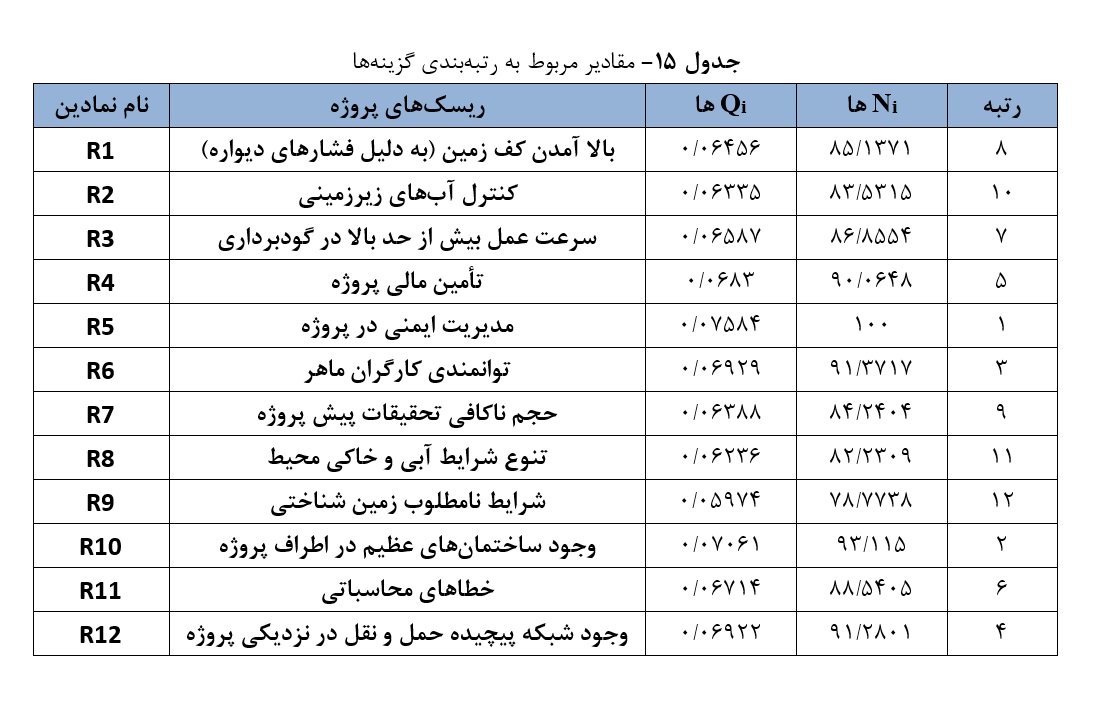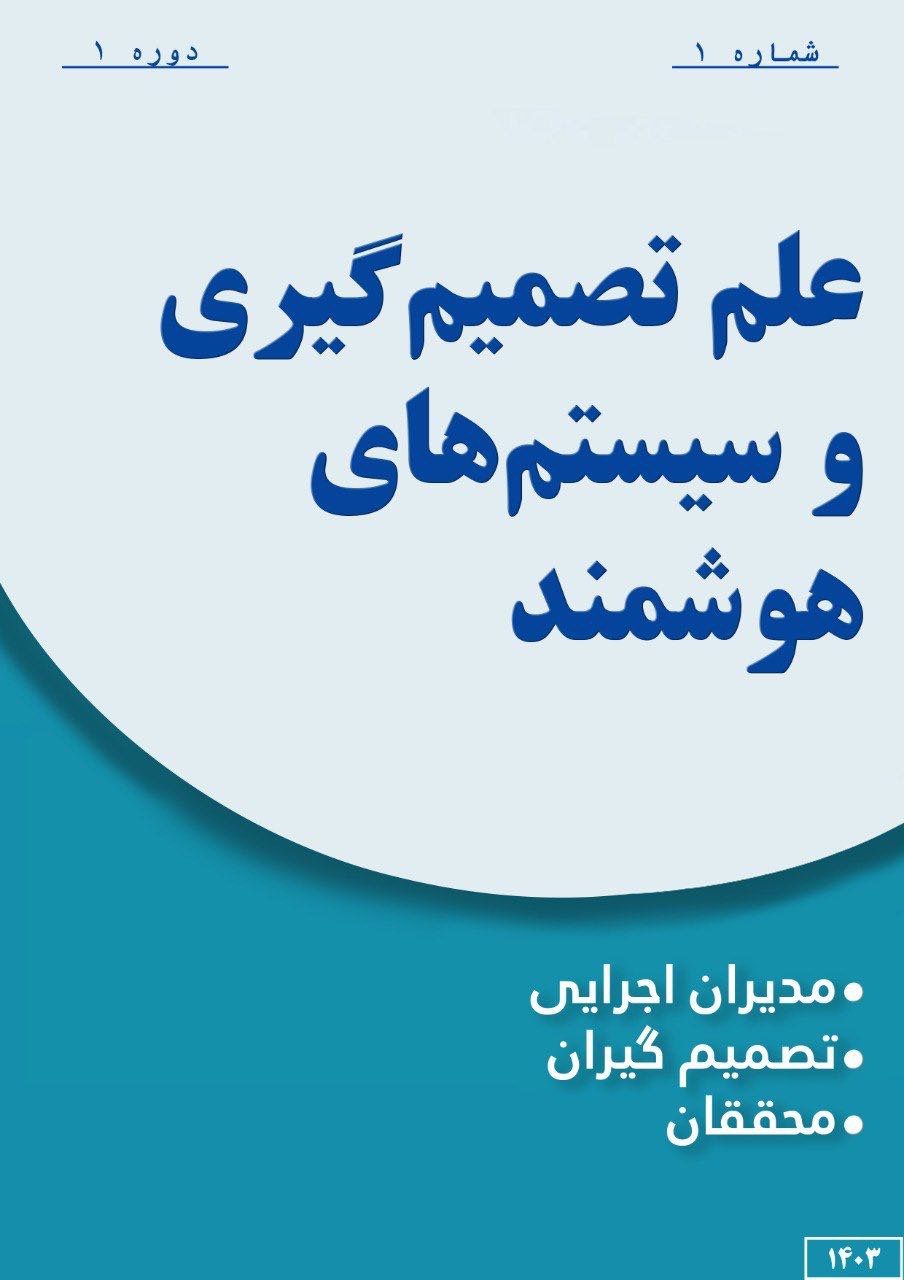ارزیابی ریسک گودبرداری عمیق پروژههای ساختمانی با رویکرد ترکیبی سوارا-کوپراس در محیط فازی
کلمات کلیدی:
گودبرداری عمیق, پروژههای ساختمانی, سوارای فازی, کوپراس فازی, مدیریت ریسکچکیده
امروزه و با توسعه زندگی شهری در اقصی نقاط جهان، توسعه فعالیتهای ساختوساز در بخشهای مختلف شهری اعم از پروژههای بلندمرتبهسازی تا پروژههای توسعه خطوط مترو، امری بهشدت ملموس و البته اجتنابناپذیر است. این پژوهش در جهت ارزیابی ریسک گودبرداری عمیق پروژههای ساختمانی انجام گرفته است. در این مطالعه بهمنظور شناسایی شاخصهای ارزیابی ریسک و نیز رتبهبندی ریسکهای مرتبط با پروژه، از رویکرد ترکیبی سوارا و کوپراس در محیط فازی استفاده گردیده است. محیط پژوهش پروژه گودبرداری عمیق بیمارستان آتیه غرب در شهر تهران بوده و دادههای مورد نیاز از خبرگان این پروژه در فاز گودبرداری گردآوری شده است. مبتنی بر تحلیل دادههای پژوهش در دو گام مختلف آن، نخست معین گردید که 11 شاخص ارزیابی ریسک، مهمترین شاخصها در زمینه سنجش ریسکهای فعالیتهای گودبرداری عمیق را شکل میدهند که در میان این شاخصها، شاخصهای قابلیت تحلیل ریسک، میزان منحصربهفرد بودن ریسک و میزان آسیبپذیری پروژه از ریسک بهعنوان مهمترین شاخصهای ارزیابی ریسکهای پروژههای گودبرداری عمیق شناسایی گردید. بهعلاوه مبتنی بر گام دوم تحلیل، اینگونه شناسایی گردید که پروژه گودبرداری بیمارستان آتیه غرب دربردارنده 12 ریسک کلیدی و اصلی میباشد. رویکرد کوپراس فازی نشان میدهد که در میان این ریسکها، سه ریسک مدیریت ایمنی در پروژه، وجود ساختمانهای عظیم در اطراف پروژه و توانمندی کارگران ماهر بهعنوان سه ریسک کلیدی شناسایی گردیده و بعد از این عوامل نیز سه عامل مهم دیگر شامل وجود شبکه پیچیده حملونقل در نزدیکی پروژه، تأمین مالی پروژه و خطاهای محاسباتی احتمالی از دیگر ریسکها مهم در این پروژه بودند. در ادامه نیز پیشنهادها و راهکارهایی در جهت کاستن از ریسکهای پروژههای گودبرداری مشابه در آینده مبتنی بر نظرات خبرگان و استانداردهای موجود ارائه شده است.
مراجع
Akintoye, A. S., & MacLeod, M. J. (1997). Risk analysis and management in construction. International Journal of Project Management, 15(1), 31–38.
Alizadeh Derakhshi, A., & Ardalan Feili, A. (2018). Risk management in urban excavation. In Proceedings of the First International Congress on the Construction Industry with a Focus on New Technologies in the Construction Industry (Tabriz, Iran). East Azerbaijan Young Engineers Association.
Asadi, M. R., Zoghi, H., & Habibi, M. (2017). Identification and ranking of high-rise building project risks using the FMEA approach in Tehran. In Proceedings of the Second National Conference on Applied Research in Civil Engineering (Structural Engineering and Construction Management). Sharif University of Technology.
Chapman, C., & Ward, S. (2003). Project risk management: Processes, techniques and insights. John Wiley & Sons.
Chatterjee, K., Zavadskas, E., Tamošaitienė, J., Adhikary, K., & Kar, S. (2018). A hybrid MCDM technique for risk management in construction projects. Symmetry, 10(2), 46.
Emamgholizadeh, S., & Hosseini, S. A. (2020). Identification and ranking of safety risks in construction projects using combined FMEA and fuzzy TOPSIS approach. Occupational Medicine, 12(1), 13–23. https://sid.ir/paper/959094/fa
English Sources
Fadaei, F., Ajdari Moghadam, M., & Shahreki, M. R. (2022). Risk assessment of dam construction projects using the PROMETHEE and GIAIA methods. Journal of Structural and Construction Engineering, 9(8), 117–137. https://doi.org/10.22065/jsce.2022.299099.2526
Fazli, M., Afshari, A. J., & Hajiaghaei-Keshteli, M. (2018, May). Identification and ranking of risks in green building projects using the hybrid SWARA-COPRAS method. In Proceedings of the International Conference of Iranian Operations Research Society (pp. 2–4). Kermanshah, Iran.
General Directorate of Engineering Services of the Tehran Province Construction Engineering Organization. (n.d.). General guide for supervising engineers: Familiarity with operational steps in effective project supervision (pp. 5–6).
Hatefi, S. M., & Tamošaitienė, J. (2019). An integrated fuzzy DEMATEL-fuzzy ANP model for evaluating construction projects by considering interrelationships among risk factors. Journal of Civil Engineering and Management, 25(2), 114–131.
Hong, Q. K., Wang, J. B., Ge, J., & Chen, P. (2013). Research on the risk of deep foundation excavation engineering management based on RBS and AHP. In Applied Mechanics and Materials (Vol. 438, pp. 1010–1014). Trans Tech Publications.
Huang, Z., Cao, C., & Zhang, W. (2024). Risk assessment method of deep foundation pit construction based on two-dimensional cloud model. Journal of Northeastern University (Natural Science), 45(10), 1504.
Lei, Z., Wang, Y., Zhang, Y., Gu, F., Zan, Z., Mei, Y., ... & Zhou, D. (2024). Advanced risk assessment for deep excavation in karst regions using improved Dempster–Shafer and dynamic Bayesian networks. Buildings, 14(9), 3022.
Lin, S. S., Zhang, N., Zhou, A., & Shen, S. L. (2022). Risk evaluation of excavation based on fuzzy decision-making model. Automation in Construction, 136, 104143.
Mashhudi, S. (1997). High-rise construction in Tehran and required guiding and preventive regulations. In Proceedings of the First National Conference on High-Rise Buildings in Iran (Vol. 2). Iran University of Science and Technology.
Mavi, R. K., Goh, M., & Zarbakhshnia, N. (2017). Sustainable third-party reverse logistic provider selection with fuzzy SWARA and fuzzy MOORA in plastic industry. The International Journal of Advanced Manufacturing Technology, 91(5–8), 2401–2418.
Ministry of Housing and Urban Development of Iran. (2006). Iran National Building Regulations: Topic 12 — Safety and protection during construction. Office for Compilation and Promotion of National Building Regulations, Tehran.
Ministry of Housing and Urban Development of Iran. (2007). Iran National Building Regulations: Topic 7 — Foundations and substructures. Office for Compilation and Promotion of National Building Regulations, Tehran.
Olfat, L., Khosravani, F., & Jalali, R. (2010). Identification and prioritization of project risks based on the PMBOK standard with a fuzzy approach. Journal of Industrial Management Studies, 8(19), 147–163.
Pan, Y., Zhou, X., Chen, J. J., & Hong, Y. (2025). Temporal-spatial-fusion-based risk assessment on the adjacent building during deep excavation. Information Fusion, 114, 102653.
Project Management Institute. (2008). A guide to the project management body of knowledge (PMBOK® Guide) (4th ed.). Maryland, USA.
Project Management Institute. (2017). PMBOK® Guide (6th ed., pp. 263–266).
Puller, M. (2003). Deep excavations: A practical manual (2nd ed.). Thomas Telford Limited.
Shen, S. L., Lin, S. S., & Zhou, A. (2023). A cloud model-based approach for risk analysis of excavation system. Reliability Engineering & System Safety, 231, 108984.
Tah, J., & Carr, V. (2001). Towards a framework for project risk knowledge management in the construction supply chain. Advances in Engineering Software, 32(10–11), 835–846. https://doi.org/10.1016/S0965-9978(01)00035-7
Taylan, O., Bafail, A. O., Abdulaal, R. M., & Kabli, M. R. (2014). Construction projects selection and risk assessment by fuzzy AHP and fuzzy TOPSIS methodologies. Applied Soft Computing, 17, 105–116.
Turskis, Z., Daniūnas, A., Zavadskas, E. K., & Medzvieckas, J. (2016). Multicriteria evaluation of building foundation alternatives. Computer-Aided Civil and Infrastructure Engineering, 31(9), 717–729.
Valipour, A., Yahaya, N., Md Noor, N., Antuchevičienė, J., & Tamošaitienė, J. (2017). Hybrid SWARA-COPRAS method for risk assessment in deep foundation excavation project: An Iranian case study. Journal of Civil Engineering and Management, 23(4), 524–532.
Vesković, S., Stević, Ž., Stojić, G., Vasiljević, M., & Milinković, S. (2018). Evaluation of the railway management model by using a new integrated model DELPHI-SWARA-MABAC. Decision Making: Applications in Management and Engineering, 1(2), 34–50.
Wang, J., Lin, W., & Huang, Y. H. (2010). A performance-oriented risk management framework for innovative R&D projects. Technovation, 30(11–12), 601–611.
Wang, N., Xu, C. S., Du, X. L., & Zhang, M. J. (2018). A risk assessment method of deep excavation based on Bayesian analysis and expert elicitation. International Journal of System Assurance Engineering and Management, 9(2), 452–466.
Zavadskas, E. K., & Kaklauskas, A. (1996). Pastatų sistemotechninis įvertinimas [Multicriteria evaluation of building]. Technika.
Zhang, L., & Li, H. (2022). Construction risk assessment of deep foundation pit projects based on the projection pursuit method and improved set pair analysis. Applied Sciences, 12(4), 1922.
Zhou, H. B., & Zhang, H. (2011). Risk assessment methodology for a deep foundation pit construction project in Shanghai, China. Journal of Construction Engineering and Management, 137(12), 1185–1194.

دانلود
چاپ شده
ارسال
بازنگری
پذیرش
شماره
نوع مقاله
مجوز
حق نشر 2025 المیرا جعفرزاده, مهدی یزدانی, عادل پورقادر چوبر (نویسنده)

این پروژه تحت مجوز بین المللی Creative Commons Attribution-NonCommercial 4.0 می باشد.





